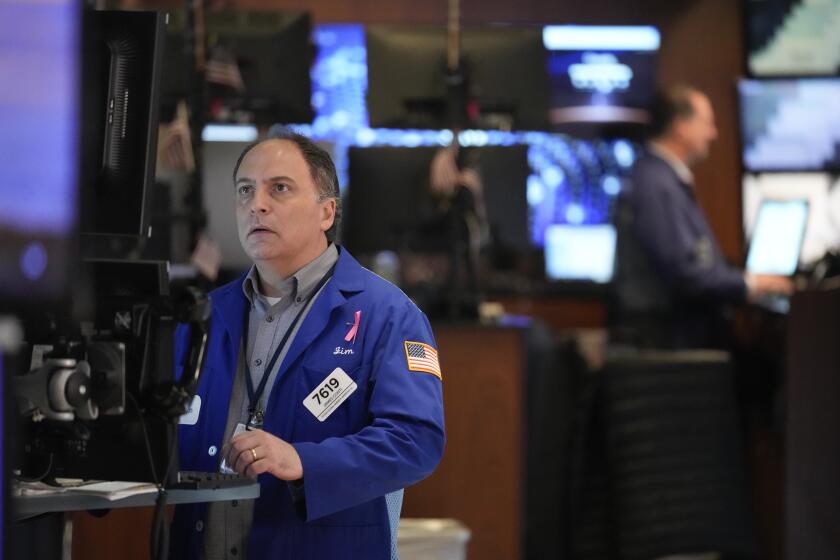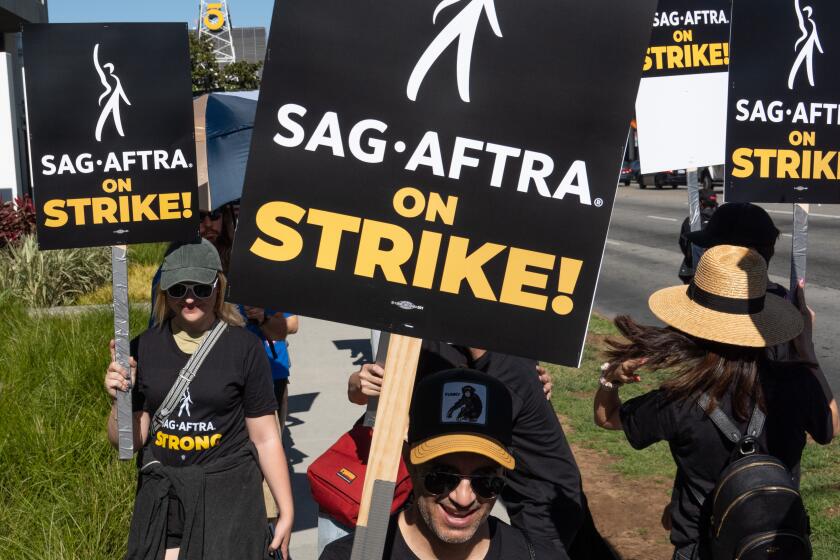Airline Profits Are Sky High : But Turbulent Economy, Rising Fuel Costs May Cloud Industry’s Future
Pushed along by substantially higher fares, some lower costs and a surging business climate, the nation’s airlines--with just a couple of exceptions--have been soaring in 1988.
Collectively, operating earnings of the industry climbed sharply in the first half of the year and are expected to hit a record high for all of 1988--possibly totaling $3 billion.
“Record third-quarter earnings appear on track,” said Michael W. Derchin, an airline analyst with the New York investment bank of Drexel Burnham Lambert.
Specific predictions for all of 1988 vary, but they all point to a record.
Timothy Pettee, airline analyst with Bear, Stearns & Co., a New York stock brokerage, forecast operating earnings for the industry of $2.7 billion to $2.8 billion. Paul Karos, his counterpart at First Boston, another New York securities firm, predicted that they will range between $2.7 billion and $3 billion.
The previous record was set last year with $2.4 billion, which exceeded 1984’s $2.1-billion mark.
(Operating earnings are an airline’s profit from flying and do not include such pluses and minuses as income from asset sales or payments on interest and taxes).
But the good times for the airlines may not last, and some close observers of the industry said they doubt seriously whether they will continue into 1989.
If the economy dips, or if airlines cannot maintain their current high fares, or if fuel costs rise, the carriers could be in for big trouble. Some analysts predict that that is just what will happen next year.
The airlines are vulnerable, the observers maintain, because their profit margins--profit as a percentage of sales--have stayed flat. In other words, while traffic (and thus revenue) has risen about 12.5% during the first six months of this year compared to the same period in 1987, costs have also increased.
The robust economy, which has pushed along both domestic and international travel, is an important reason for the current profit surge, which is also credited in part to the reduced level of competition--and higher fares--that began to emerge in mid-1987 with the demise of low-cost carriers--notably People Express. That discount airline, which was taken over by the Texas Air holding company, had been driving fares down for the entire industry.
The trend toward higher fares is continuing. Discount fares rose again on Sept. 1. The increases were relatively small, but they were industrywide. The new higher discount fares will raise the cost of one-way fares by $2 to $10. The cost of a round-trip discount fare will rise as much as $20.
Airline watchers say that Texas Air, hurting from staggering losses this year, has abandoned its role as the low-fare trend setter. As a result, other airlines are freer to raise fares without having worry so much about which way Texas Air and its two big airlines--Eastern and Continental--will jump.
“Airline earnings have been extremely strong recently as fares increased throughout the spring and summer,” said Robert McAdoo, airline analyst for Oppenheimer & Co., another New York brokerage. “Outlook for fares and traffic this fall is substantially stronger than usual.”
Less Competition a Help
According to Drexel’s Derchin, three-quarters of the current earnings improvement is a function of the new, less competitive industry environment and the rest is due to the apparent strength of the economy.
First Boston’s Karos calculated that average fares were 10% to 11% higher during the first six months of 1988 than in the same period last year. He noted that Texas Air, which had been keeping fares low, put a number of increases into effect last spring. And they stuck, as competitors went along and raised their fares to match.
At about the same time, Texas Air also eliminated a string of business discount fares, and its competitors followed. This made it much more difficult for business travelers to fly on discount fares.
“Business people have been forced to pay full fare,” Karos said.
And that, Pettee said, “is not nickel-and-dime stuff.”
The profit increases have come despite a decline in passenger traffic in some cases. Figures supplied by the Los Angeles Area Chamber of Commerce, for example, showed that traffic at Los Angeles County’s three largest airports--Los Angeles International, Glendale/Burbank/Pasadena and Long Beach--dropped 2.95% during the first half of this year.
Fuel Costs Lower
But generally speaking, profit per passenger is rising sharply. Helping the operating profit increases along has been a decline in the price of jet fuel, which accounts for about 20% of total airline expenses. The price has dropped to about 53 cents a gallon from 57 cents to 58 cents at this time last year. Every penny-a-gallon decrease in jet fuel prices results in a saving of about $135 million for the entire U.S. airline industry, Karos said.
In the past, such fuel-cost reductions have been passed on to the consumer through lower fares, so profits did not increase. However, that has changed, and the current fuel cost savings have been retained by the airlines.
The lower price of fuel has helped offset higher costs of labor and dramatically higher commissions paid to travel agents. Labor costs, it is estimated, have risen about 7% in a year, and commission costs have climbed more than 10%. American carriers have been forced to match the commissions that foreign airlines pay travel agents to lure the lucrative international business. These commissions range between 30% and 40% in some countries.
There has also been a rise of about 5% in costs. But that has been outweighed by the dip in fuel prices and by higher fares.
So the airlines are earning more per passenger than they used to. Yields (the average amount of revenue received for carrying one passenger one mile, expressed in cents), for the industry rose 9% in the first quarter of 1988, compared to year-ago period. In the second quarter, they were 10% over 1987’s second quarter.
Industrywide, yields in the first quarter of this year averaged 11.3 cents and rose in the second quarter to 11.5 cents. The nation’s eight major airline companies, helped by the improved yields, reported $884.4 million in operating profits in the second quarter, according to the respected Aviation Daily newsletter. That is a 4.5% increase over 1987 and occurred despite a quarterly loss of $128.3 million by Texas Air.
The company’s Eastern and Continental airlines have been suffering from a public image problem associated with highly publicized safety and service problems. In addition, Eastern has suffered from continued labor unrest that has affected the productivity of employees.
Greatly Improved Profits
Not counting the Houston-based holding company, the remaining seven majors (airline companies with annual revenue of $1 billion or more) earned a little more than $1 billion in quarterly operating profit, a 37.3% increase over the same period last year.
The majors are not alone in their excellent results. Nine publicly owned national carriers (those with annual revenue of $100 million to $1 billion) made a major financial improvement in the second quarter.
Their combined operating profits were $60 million, more than 3 1/2 times their earnings in the same period last year. The nationals’ strong improvement boosted quarterly operating profit of the industry’s 17 largest publicly traded airlines to $944 million, a 9.5% increase over a year earlier.
American, United and Delta garnered by far the largest share--72.3%--of those 17 airlines’ operating earnings in the first half of the year. As proof that they have been able to cut costs and get better yields from the traffic they have carried, the three airlines’ combined operating revenues, $12.1 billion, totaled only 44.1% of the $27.4 billion reported by the majors and the nationals in the first half.
Warnings Persist
Texas Air dramatically lowered the collective results of these carriers. Excluding the money-losing owner of Eastern and Continental, collective second-quarter operating profit of the other 16 rose more than 42% to $1.07 billion from $753.6 million in the same period of 1987.
But the danger signals for the future persist.
The airlines “are not making any extra money on these incremental dollars of revenues, which theoretically they should be doing,” said Edward J. Starkman, airline analyst with the New York investment firm of Paine Webber Inc. “Thus, if traffic dips, everything comes down. Everyone is waiting so see what will happen after Labor Day--more important, what happens in 1989.
“This year has been a great year, but everyone is jittery about next year.”
AIRLINE OPERATING PROFITS (AND LOSSES)
‘87 First 6 Months ’88 First 6 Months Airline in millions in millions American $236.6 $371.7 Delta 183.5 261.3 Northwest 61.7 (24.4)* Pan Am (21.8) (36.9) Texas Air 160.7 (127.3) TWA 71.9 98.6 United 108 301.3 USAir 127.7 187.8
* () Indicates loss






